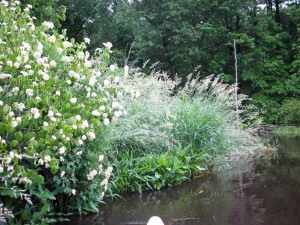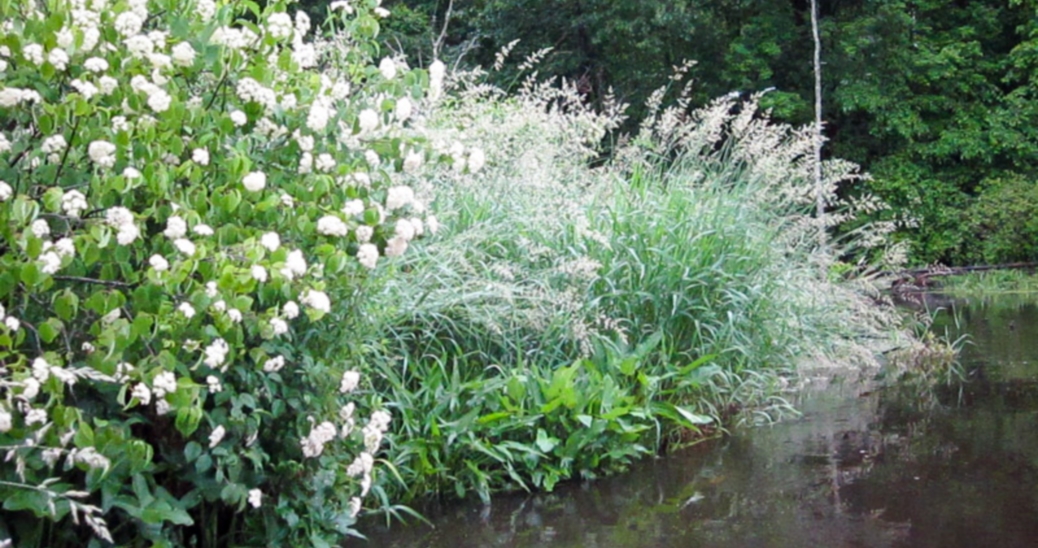Water Closet for June 27, 2014
The other day on the Middleton Stream Team’s annual June paddle down river we were delighted by the lush green canyon with walls of swamp dogwood, reed-canary grass, and a half dozen other wetland plants. The dogwood is now in full flower with heads of tiny white blossoms. The reed-canary grasses’ handsome but petal-less flowers have been with us since late May changing color to a now whitish gray, some tinged with maroon that contrast with bright green leaves below. [pullquote]”It is a shame when you consider it took 10,000 years from the last continental glacier for just 10 inches of valuable topsoil to form.”[/pullquote]Beneath them on the edges, out at paddle length, smartweed, pickerelweed, arrowhead and bur-reed crowd much of the river’s watery shoulders. On the surface just off the channel and in side coves are thin rafts of tiny duckweed.* A few inches under water the lance shaped leaves of Potamogeton natans on slender stems point in the direction of current flow. Had a dense fog come down we could have used the leaves as pointers. Screened from any breeze all was calm, and except for people and birds, quiet. Dragonflies cheered us all along the way. Besides their beauty they are responsible for the absence of mosquitoes. Several paddlers noted that they hadn’t seen a mosquito in the five miles traveled.
Some of us tried to imagine the extensive root systems in muck under water. From the lowermost tips of the roots to the tops of the dense reed-canary grass stems is an eight-foot thick labyrinth of vegetation; all of living-active cells. In the mud between microscopic root hairs are bacteria and fungi; a three yard thick blanket upon the Earth of living filters, absorbers, producers and more in symbiotic relationships.

Lush June gardens all along the edges of the Ipswich River – The bush in full bloom, foreground left, is Swamp Dogwood. In the background and along much of the river are dense stands of Reed-canary Grass. A patch of Arrowhead is between the dogwood and grass. These and other water loving plants thrive in the year round water.
– Judy Schneider photo
The green parts in the sun are making food; the cells in the dark below are taking in water, exchanging ions, and acting as filters. In the red wood groves of California this layer of life is 300 feet thick; around here in a few stands of high white pines, 120 feet. In deserts the layers are much thinner and less dense. Our fields with up to a foot of topsoil are rich in macro and microscopic life where not poisoned by man. By late summer nine feet of corn are a very effective photosynthetic layer of production above extensive root systems supporting, anchoring, absorbing and filtering below. The poorest surfaces in terms of life are those of asphalt and lawns especially when the latter are routinely poisoned by those insisting on boring monocultures of unnatural greens. One reprehensible practice by certain developers and contractors around our towns is to leave their houses with only 2 to 4 inches of living loam out of the 8 to 12 there at the start. They sell it off to others leaving their customers with poor bases for lawns for many generations to come. Such thin soiled lawns require much more care to obtain a cosmetically acceptable green. Herbicides, unnecessary fertilizers, insecticides and excess water are applied. It is a shame when you consider it took 10,000 years from the last continental glacier for just 10 inches of valuable topsoil to form.
These thin and thick surface strata are the living layers of the continents. The water layers of the oceans covering three-fourths of the planet are much thicker. We now know their water and the life contained within are critically important to the Earth’s health as a whole. Even in the bottom of ocean “trenches” up to seven miles deep there is life. On the continental shelves it is dense. In the upper 600 feet where there is some light photosynthesis occurs. Down in the eternal dark where molten magma oozes forth chemo synthesis by bacterial cells makes food, its source of energy heat.
We’ve learned much of what has been so briefly described above in just the last two centuries of man’s 10,000 year written history, the big picture for many has just come in the last few decades. High schoolers are taught this in biology. We know, yet don’t always treat soil, water, and air as valuable essentials. Yearly, soils are scraped off, buried, or allowed to wash away. Peabody and Danvers once important agricultural centers are now shopping centers. Asphalt and buildings have replaced topsoil. The oceans are used as dumps and sewers worldwide, as the rivers once were here. Soil, water, and air are recipients of hundreds of man-made chemicals. What these do to the life within is largely unknown despite the fact we have now learned how to find out. Too many make no attempt, the bottom line is summed up in the slogan, “It’s the economy stupid!” In polls about human concerns the environment is often far down on the lists. Understandably wars and jobs are high. If we had less of the former and more of the latter the numbers for the environment would rise. If the environment was near the top where it should be jobs and peace might follow. A John Lennon hit back in the Viet Nam days was “Give peace a chance.” It was sung while our country rained down bombs, napalm, and Agent Orange on the thick vegetation and soils of Viet Nam. The refrain with a substitution still very much applies. “All we are saying is give LIFE a chance.”
The tranquility and luxuriant life on the river in the company of dragonflies and birds led to these thoughts of what might be. And again as with the song, “All we are saying is give LIFE a chance.”
* The scientific names of these flowering plants, some unfortunately called “weeds”, are:
silky dogwood – Cornus amomum; reed-canary grass – Phalaris arundinacea; arrowhead – Sagittaria sp.; pickerelweed – Pontederia cordata; bur-reed – Sparganium sp.; and duckweed – Spirodela sp. Visit the river and its tributaries at different times of the year. These and a dozen other species put on quite a show.
_______________________________________________________________________
WATER RESOURCE AND CONSERVATION INFORMATION
FOR MIDDLETON, BOXFORD AND TOPSFIELD
| Precipitation Data* for Month of: | March | April | May | June | |
| 30 Year Normal (1981 – 2010) Inches | 4.65 | 4.53 | 4.06 | 3.95 | |
| 2013 – 14 Central Watershed Actual | 4.32 | 2.86 | 2.77 | 1.6 of 6/24** | |
Ipswich R. Flow Rate(S. Middleton USGS Gage) in Cubic Feet/ Second (CFS):
For June 24, 2014 Normal . . . 18CFS Current Rate . . . 6.7CFS
*Danvers Water Filtration Plant, Lake Street, Middleton is the source for actual precipitation data thru May. Normalsdata is from the National Climatic Data Center.
**Updated June precipitation data is from MST gage..
THE WATER CLOSET is provided by the Middleton Stream Team: www.middletonstreamteam.org or <MSTMiddletonMA@gmail.com> or (978) 777-4584

